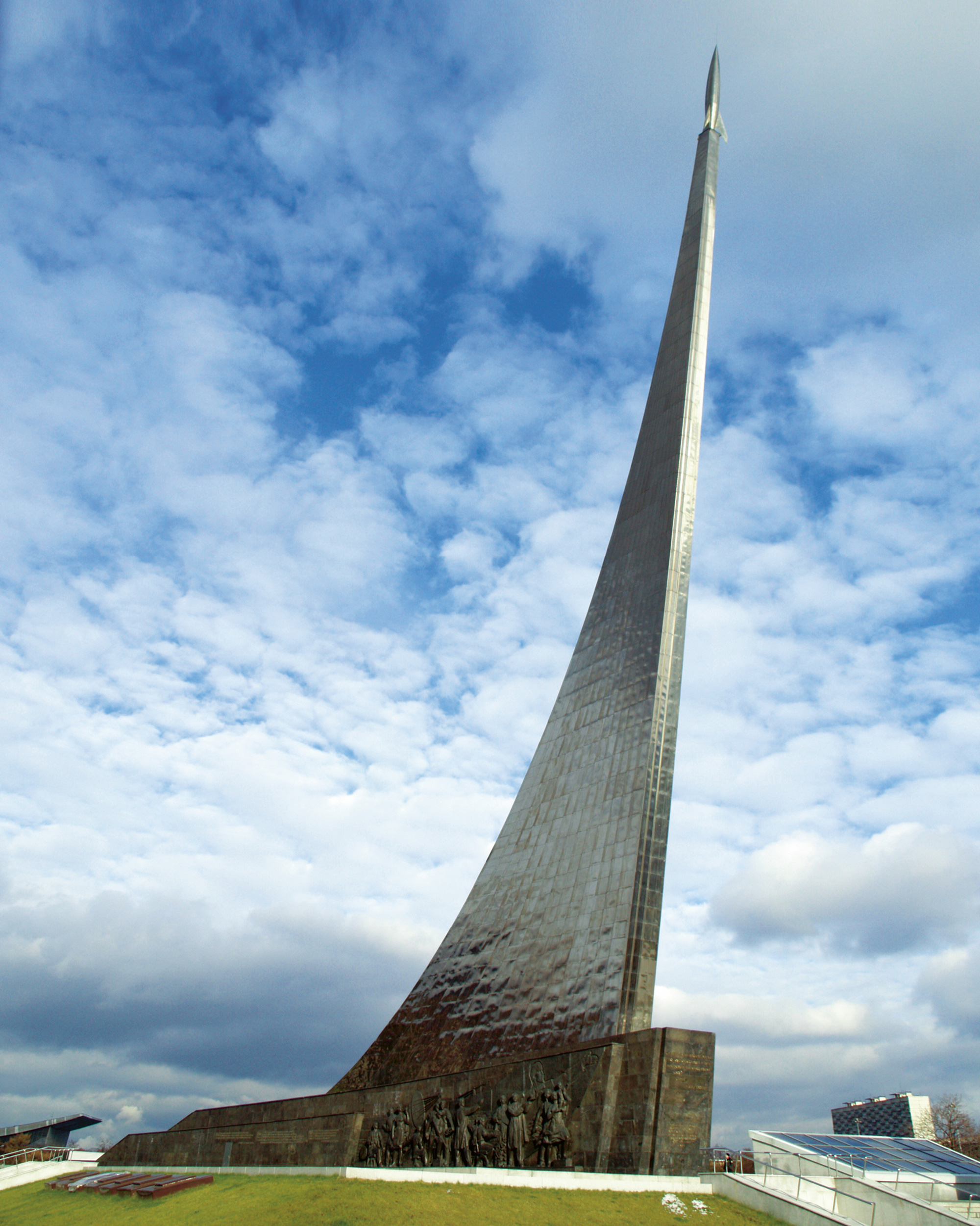Spring 2015
Red Star Theater
Architecture, technology, and the Soviet dream of the cosmos
William Firebrace
THREE
In the skies over Moscow, in the years before the collapse of the socialist state, stood three symbols of the space program: the rocket, the cosmonaut, and the red star. The rocket remains on the Monument to the Conquerors of Space (1964), a 110-meter-high titanium sculpture beside Mira Prospekt with the Alley of the Cosmonauts leading to its base. The Yuri Gargarin monument (1980)—featuring a statue of the cosmonaut on a 30-meter-high column with his arms pulled back in the style of a Marvel superhero, as though about to leap into the stratosphere—continues to overlook Leninsky Prospekt. These two landmarks at once look back to the period of Soviet space exploration and forward to the time of planetary probes and space stations. But the red star—symbol both of astronomy and of communism—is gone. Preceding the epic period of space flights, it once crowned the dome of the Moscow planetarium (1929), on Sadovaya-Kudrinskaya Ulitsa.
PATTERNS
Some buildings derive from tangled threads of different influences, which unexpectedly intertwine at the moment of their creation and which continue to exert an influence for many years. Some of these influences are tangential, some central; some are clearly defined, some discerned only through the traces they leave. Together, they indicate a pattern of movement rather than a simple object. The Moscow planetarium, a comparatively simple building, stands at the intersection of influences created by engineering, style, theater, astronomy, religion, and politics, each of which affects all the others.
Moscow’s Monument to the Conquerors of Space in 2009. Photo Jaime Silva.
PROJECTION
The Moscow planetarium is a variation on the original projection planetarium, invented by the German mechanical engineer Walther Bauersfeld and built in 1923 on the roof of the Zeiss factory in Jena. This experimental planetarium was the first to feature the Zeiss projector, whose complex sets of individual lamps, each moving on their own course, could project up onto a hemispherical screen the paths of the planets, the movement of comets, and the relative brightness of the distant stars and galaxies. It was also the first building to feature a thin shell dome, designed by Bauersfeld and the engineer Franz Dischinger, based on a geodesic structure of thin metal rods sprayed with cement. Planetariums immediately became a craze in Germany and then in Europe, a must-have item for cities on the make, with the Moscow planetarium being the thirteenth to be constructed.
David Ryazanov—a former comrade in exile of Leon Trotsky and director of the Marx-Engels Institute, an organization devoted to Soviet philosophy and history—proposed the construction of the planetarium in 1926. The building was originally intended to be part of a large science complex—including a zoo, a museum, and a library—which would exemplify the rising power of pure science. Evolutionary time would be presented in the zoo and cosmic time in the planetarium, both set against the traditional religious time of the discredited Russian Orthodox Church. Ryazanov traveled to Germany to visit various planetariums and to persuade Bauersfeld and Dischinger to construct a planetarium for Moscow. At the time, the Weimar and the Soviet republics were on good terms, with considerable architectural interchange between the two. Bauersfeld and Dischinger possessed skills lacking in the USSR: the technology to construct the projector and the engineering expertise to put up the ferro-cement dome, lightweight construction and the projection of light thus combining to produce a building reduced to the minimum use of material. The new planetarium was to be on an ambitious scale, with an internal diameter of twenty-seven meters, and seating for 1,440 spectators. The Zeiss dumbbell projector provided by Bauersfeld was the latest model, able to project an astonishing 8,956 stars and to switch the projection point to various
